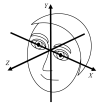Latitude and longitude vertical disparities
- PMID: 20055544
- PMCID: PMC2837276
- DOI: 10.1167/9.13.11
Latitude and longitude vertical disparities
Abstract
The literature on vertical disparity is complicated by the fact that several different definitions of the term "vertical disparity" are in common use, often without a clear statement about which is intended or a widespread appreciation of the properties of the different definitions. Here, we examine two definitions of retinal vertical disparity: elevation-latitude and elevation-longitude disparities. Near the fixation point, these definitions become equivalent, but in general, they have quite different dependences on object distance and binocular eye posture, which have not previously been spelt out. We present analytical approximations for each type of vertical disparity, valid for more general conditions than previous derivations in the literature: we do not restrict ourselves to objects near the fixation point or near the plane of regard, and we allow for non-zero torsion, cyclovergence, and vertical misalignments of the eyes. We use these expressions to derive estimates of the latitude and longitude vertical disparities expected at each point in the visual field, averaged over all natural viewing. Finally, we present analytical expressions showing how binocular eye position-gaze direction, convergence, torsion, cyclovergence, and vertical misalignment-can be derived from the vertical disparity field and its derivatives at the fovea.
Figures












Similar articles
-
Does depth perception require vertical-disparity detectors?J Vis. 2006 Nov 20;6(12):1323-55. doi: 10.1167/6.12.1. J Vis. 2006. PMID: 17209738
-
Perceiving slant about a horizontal axis from stereopsis.J Vis. 2001;1(2):55-79. doi: 10.1167/1.2.1. J Vis. 2001. PMID: 12678602
-
Vergence eye movements in response to binocular disparity without depth perception.Nature. 1997 Sep 18;389(6648):283-6. doi: 10.1038/38496. Nature. 1997. PMID: 9305842
-
Binocular eye movements and the perception of depth.Rev Oculomot Res. 1990;4:213-61. Rev Oculomot Res. 1990. PMID: 7492529 Review. No abstract available.
-
Neuromuscular plasticity and rehabilitation of the ocular near response.Optom Vis Sci. 2009 Jul;86(7):E788-802. doi: 10.1097/OPX.0b013e3181ae00a5. Optom Vis Sci. 2009. PMID: 19543139 Review.
Cited by
-
Stereo vision and strabismus.Eye (Lond). 2015 Feb;29(2):214-24. doi: 10.1038/eye.2014.279. Epub 2014 Dec 5. Eye (Lond). 2015. PMID: 25475234 Free PMC article. Review.
-
The Role of Vertical Disparity in Distance and Depth Perception as Revealed by Different Stereo-Camera Configurations.Iperception. 2016 Dec 6;7(6):2041669516681308. doi: 10.1177/2041669516681308. eCollection 2016 Nov-Dec. Iperception. 2016. PMID: 27994843 Free PMC article.
-
The Statistics of Eye Movements and Binocular Disparities during VR Gaming: Implications for Headset Design.ACM Trans Graph. 2023 Feb;42(1):7. doi: 10.1145/3549529. Epub 2023 Jan 19. ACM Trans Graph. 2023. PMID: 37122317 Free PMC article.
-
Active Vision in Binocular Depth Estimation: A Top-Down Perspective.Biomimetics (Basel). 2023 Sep 21;8(5):445. doi: 10.3390/biomimetics8050445. Biomimetics (Basel). 2023. PMID: 37754196 Free PMC article.
-
On the inverse problem of binocular 3D motion perception.PLoS Comput Biol. 2010 Nov 18;6(11):e1000999. doi: 10.1371/journal.pcbi.1000999. PLoS Comput Biol. 2010. PMID: 21124957 Free PMC article.
References
-
- Adams W, Frisby JP, Buckley D, Garding J, Hippisley-Cox SD, Porrill J. Pooling of vertical disparities by the human visual system. Perception. 1996;25(2):165–176. - PubMed
-
- Allison RS, Rogers BJ, Bradshaw MF. Geometric and induced effects in binocular stereopsis and motion parallax. Vision Res. 2003;43(17):1879–1893. - PubMed
-
- Backus BT, Banks MS. Estimator reliability and distance scaling in stereoscopic slant perception. Perception. 1999;28(2):217–242. - PubMed
-
- Backus BT, Banks MS, van Ee R, Crowell JA. Horizontal and vertical disparity, eye position, and stereoscopic slant perception. Vision Res. 1999;39(6):1143–1170. - PubMed
-
- Banks MS, Backus BT. Extra-retinal and perspective cues cause the small range of the induced effect. Vision Res. 1998;38(2):187–194. - PubMed
Publication types
MeSH terms
Grants and funding
LinkOut - more resources
Full Text Sources

